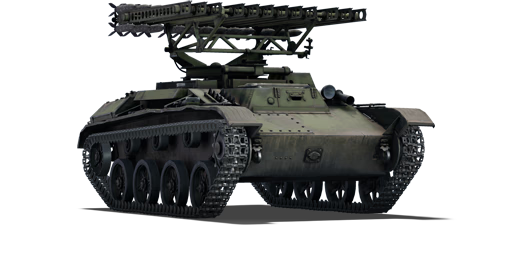

Ground Vehicles
BM-8-24
I
Rank
AB
1.3
RB
1.3
SB
1.3
Battle rating
USSR
Game nation
Tank destroyer
Main role
3,850

Purchase

Premium vehicle
Status
General information
Survivability and armour
Armour
front / side / back
Hull
35 / 15 / 25 mm
Turret
25 / 25 / 25 mm
Visibility
125 %
Crew
2 persons
Mobility
Max speed
Forward
4347 km/h
Backward
6 km/h
Power-to-weight ratio
13.111.622.918.6 hp/t
Engine power
7667133108 hp
Weight
5.8 t
Optics
Gunner
Commander
Driver
Optics zoom
1.9x–3.5x
—
—
Armaments
82 mm M-8 rocket
Ammunition
24 rounds
Fire rate
180 shots/min
Vertical guidance
-3 / 40°
Horizontal guidance
-13 / 13°
Turret Rotation Speed
basic crew → aces
Horizontal
10.58.918.313.2 → 1512.826.118.9 °/s
Vertical
3.52.810.76.8 → 5415.29.8 °/s
| Ammunition | Type | Armor penetration (mm) at a distance: | |||||
|---|---|---|---|---|---|---|---|
| 10 m | 100 m | 500 m | 1000 m | 1500 m | 2000 m | ||
| R | 9 | 9 | 9 | 9 | 9 | 9 | |
Economy
Repair cost
AB
1,244 

RB
1,328 

SB
726 

Crew training
2,300 

Experts
15,000 

Aces
115 

Research Aces
320,000 

Reward multiplier
AB / RB / SB
 2 x (55 / 85 / 75) %
2 x (55 / 85 / 75) % 
 2 x 112 %
2 x 112 % 

Premium vehicle
All modifications are unlocked
Mobility | |
|---|---|
Protection |
|---|
Firepower |
|---|
Rating by players
You must play more than 3 battles for the last week and more than 10 battles in a vehicle to rate it.
Like:
14
Armor protection:
Not enough ratings
Survivability:
Not enough ratings
Mobility:
Not enough ratings
Armament:
Not enough ratings
Balance:
Not enough ratings
Tips & Tricks
This space is currently empty
Do you know any interesting vehicle features?
Loading...
No articles about this vehicle yet
Become the first author and get rewards!
Write a guide, tell about interesting historical facts, make a tutorial or simply an interesting post.
No more content